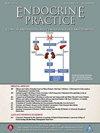Diagnosis Frequency and Associated Factors of Nonalcoholic Fatty Liver Disease Among United States Hospitalized Adults in Urban vs Rural Populations From 2007 to 2019: An Emerging Public Health Crisis
IF 4.6
3区 医学
Q2 ENDOCRINOLOGY & METABOLISM
引用次数: 0
Abstract
Objective
To describe and understand differences between United States rural and urban populations with respect to outcomes of hospitalization and related epidemiology of nonalcoholic fatty liver disease (NAFLD).
Methods
We analyzed data from the Healthcare Cost and Utilization Project National Inpatient Sample from 2007 to 2019, identifying 847 165 NAFLD cases, of which 370 131 met inclusion criteria. Statistical analyses included Pearson's chi-square, independent samples t-tests, Mann-Whitney U tests, and multivariate logistic regression models to examine factors associated with NAFLD.
Results
Hospitalizations due to NAFLD significantly increased over time from 2007 to 2019 with urban cases constituting 84.9% while rural cases represented 15.1%. Differences in demographics, hospital characteristics, insurance, income, and outcomes were significant between the 2 groups. Multivariate analysis showed higher odds of NAFLD diagnosis in fringe metro areas (adjusted odds ratio [aOR] = 1.074, 95% CI = 1.044-1.105), medium metro counties (aOR. = 1.146, 95% CI = 1.114-1.179), small metro counties (aOR = 1.182, 95% CI = 1.140-1.226), and rural regions (aO R = 1.279, 95% CI = 1.233-1.327) compared to central metro areas. NAFLD was more prevalent in females, those aged 35-49 or 50-64 years, and White patients, particularly among those with diabetes, metabolic syndrome, and obesity.
Conclusion
The increasing prevalence of NAFLD suggests a strong association with metabolic and cardiovascular diseases. With increasing closure of rural hospitals, we may see more rural patients with NAFLD admitted to urban centers. Early detection and diagnosis should help prevent long-term complications of NAFLD.
“2007年至2019年美国城市和农村住院成年人非酒精性脂肪性肝病的诊断频率和相关因素:一场新出现的公共卫生危机”。
目的:描述和理解美国农村和城市人群在非酒精性脂肪性肝病(NAFLD)住院结局和相关流行病学方面的差异。方法:分析2007 - 2019年医疗成本与利用项目(HCUP)全国住院患者样本(NIS)的数据,确定847165例NAFLD病例,其中370131例符合纳入标准。统计分析包括Pearson卡方检验、独立样本t检验、Mann-Whitney U检验和多变量logistic回归模型来检验与NAFLD相关的因素。结果:2007年至2019年期间,NAFLD住院率显著增加,城市病例占84.9%,农村病例占15.1%。两组患者在人口统计学、医院特征、保险、收入和结局方面存在显著差异。多因素分析显示,与中心城区相比,边缘城区(校正优势比[a.o.r.]=1.074, 95% CI=1.044-1.105)、中等城区(a.o.r. =1.146, 95% CI=1.114-1.179)、小城区(a.o.r. =1.182, 95% CI=1.140-1.226)和农村地区(a.o.r. =1.279, 95% CI=1.233-1.327)的NAFLD诊断几率更高。NAFLD在35-49岁或50-64岁的女性和白人患者中更为普遍,尤其是糖尿病、代谢综合征和肥胖患者。结论:NAFLD患病率的上升提示其与代谢和心血管疾病密切相关。随着越来越多的农村医院关闭,我们可能会看到更多的农村NAFLD患者被送往城市中心。早期发现和诊断应有助于预防NAFLD的长期并发症。
本文章由计算机程序翻译,如有差异,请以英文原文为准。
求助全文
约1分钟内获得全文
求助全文
来源期刊

Endocrine Practice
ENDOCRINOLOGY & METABOLISM-
CiteScore
7.60
自引率
2.40%
发文量
546
审稿时长
41 days
期刊介绍:
Endocrine Practice (ISSN: 1530-891X), a peer-reviewed journal published twelve times a year, is the official journal of the American Association of Clinical Endocrinologists (AACE). The primary mission of Endocrine Practice is to enhance the health care of patients with endocrine diseases through continuing education of practicing endocrinologists.
 求助内容:
求助内容: 应助结果提醒方式:
应助结果提醒方式:


